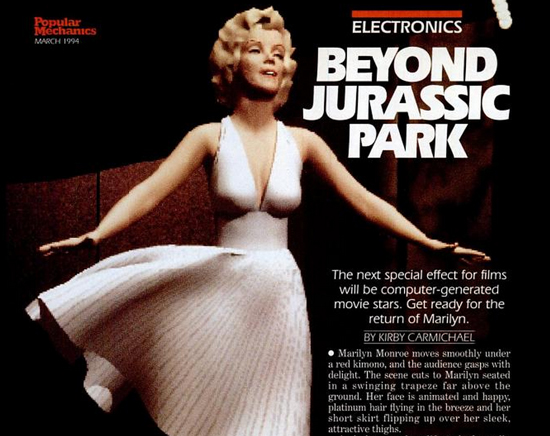Resurrecting the Dead With Computer Graphics
/https://tf-cmsv2-smithsonianmag-media.s3.amazonaws.com/filer/201204301230381994-marilyn-monroe-470x251.jpg)
A couple of weeks ago audiences at the Coachella music festival got to see Tupac perform live (NSFW language), despite the fact that he’s been dead for fifteen years. Countless websites have already dissected why the technology used to create this “Tupac hologram” isn’t actually a hologram, but rather a Pepper’s Ghost effect that dates back to the mid-19th century, so I won’t get into that. But the other fascinating element to this story is the fact that we can now RESURRECT OUR FAVORITE ENTERTAINERS FROM THE DEAD.
Bringing back popular entertainers was the promise of the future in the 1980s and ’90s. As computer graphics improved in the 1980s (with movies like Tron) and then in the 1990s (with movies like Terminator 2: Judgement Day and Jurassic Park) people imagined that actors like Clark Gable, Marilyn Monroe and even a Laurence Olivier/Abraham Lincoln mash-up would be able to star in the computer-enhanced movies of tomorrow.
Arthur C. Clarke’s 1986 book July 20, 2019: Life in the 21st Century includes a fictional movie listing for the year 2019:
Still Gone with the Wind. The sequel picks up several years after where the 80-year-old original left off, with Rhett and Scarlett reuniting in their middle age, in 1880. Features the original cast (Clark Gable, Olivia de Havilland, and Vivien Leigh) and studio sets resurrected by computer graphic synthesis. Still Gone sets out to prove that they do make ‘em like they used to (Selznick Theater, 2:00 and 8:00 P.M.)
The June, 1987 issue of Omni magazine featured an article by Marion Long, who spoke with six directors to get their ideas for the kinds of movies that they would want to direct in the year 2001. One of the directors that Long spoke to was Susan Seidelman, who in 1987 directed a movie called Making Mr. Right starring John Malkovich.
Seidelman’s hypothetical movie of the year 2001 was called Yankee Doodle Sweetheart, and was imagined as starring Marilyn Monroe, Robert De Niro, Debra Winger and Jimmy Stewart. Marilyn Monroe had been dead for 25 years by the time this article came out, and though Jimmy Stewart didn’t die until 1997, he was still pictured as playing a much more youthful (and completely computer-generated) version of himself. The synopsis of the film is below:
Seidelman electronically recreates Marilyn Monroe. The sex goddess of the Fifties plays a showgirl off to the front lines of a war on a Bob Hope USO tour. In sharp contrast to Monroe’s innocence and naivete stands Debra Winger, a military nurse acutely aware of the horrors of war. But this is Monroe’s story—her coming-of-awareness. Robert De Niro, a Marine sergeant deadened to human emotion, wants one thing: the showgirl. So does his friend, a young recruit, played a computer-simulated Jimmy Stewart. Monroe falls in love with—you’ll have to see the film.
The 1982 book The Omni Future Almanac also imagined even more radical computer creations, being able to include the acting skills of one actor with the appearance of another historical figure:
It is possible that dramatic performances, even actors’ lines, will be altered, via computer synthesis, yielding a perfect first “take” every time. Some actors, specifically character types, might be totally synthesized. One actor’s performance might easily be combined with another person’s distinctive physical look or voice. By using computer synthesis, a director would be able to marry the acting skills of Laurence Olivier to photographic images of Abraham Lincoln.

Marilyn Monroe as a computer simulation (March, 1994 Popular Mechanics)
Marilyn Monroe popped up a number of times in predictions about future movies, which may have had something to do with the fact that she died so young—she was just 36 years old. A 1993 article in the San Francisco Examiner predicted that one day, “dead actors such as Humphrey Bogart and Marilyn Monroe could be ‘resurrected’ by using computers to generate their visages and act out scenes they never did,” while the following year, Popular Mechanics ran a story that also featured Marilyn Monroe. The March, 1994 issue had an article called “Beyond Jurassic Park,” which predicted a world of resurrected movie stars now that Jurassic Park had shown just how far computer graphics had come.
Marilyn Monroe moves smoothly under a red kimono, and the audience gasps with delight. The scene cuts to Marilyn seated in a swinging trapeze far above the ground. Her face is animated and happy, platinum hair flying in the breeze and her short skirt flipping up over her sleek, attractive thighs.
As in her previous life, nobody really knows this Marilyn. This Marilyn is a computer construct—a proof-of-concept synthetic human actor used to advance the science and art of realistic 3D digital animation.
The 1990s saw TV advertisements wherein Fred Astaire danced with a vacuum cleaner and John Wayne drank beer, long after both had passed away, but it seems the “Tupac hologram” has for those of the 2010s revived interest in the idea that we might see our favorite celebrities perform for us once again.
There’s speculation that Michael Jackson may be next to take the stage from beyond the grave. Or that maybe a digital Lisa “Left Eye” Lopes will allow TLC to reunite. But allow me to be the first to request a “hologram Sheb Wooley.” Because why not, that’s why.
And, what about you? If you were making a computer-enhanced film, who would be in your dream cast of living and dead actors?
/https://tf-cmsv2-smithsonianmag-media.s3.amazonaws.com/accounts/headshot/matt-novak-240.jpg)
/https://tf-cmsv2-smithsonianmag-media.s3.amazonaws.com/accounts/headshot/matt-novak-240.jpg)